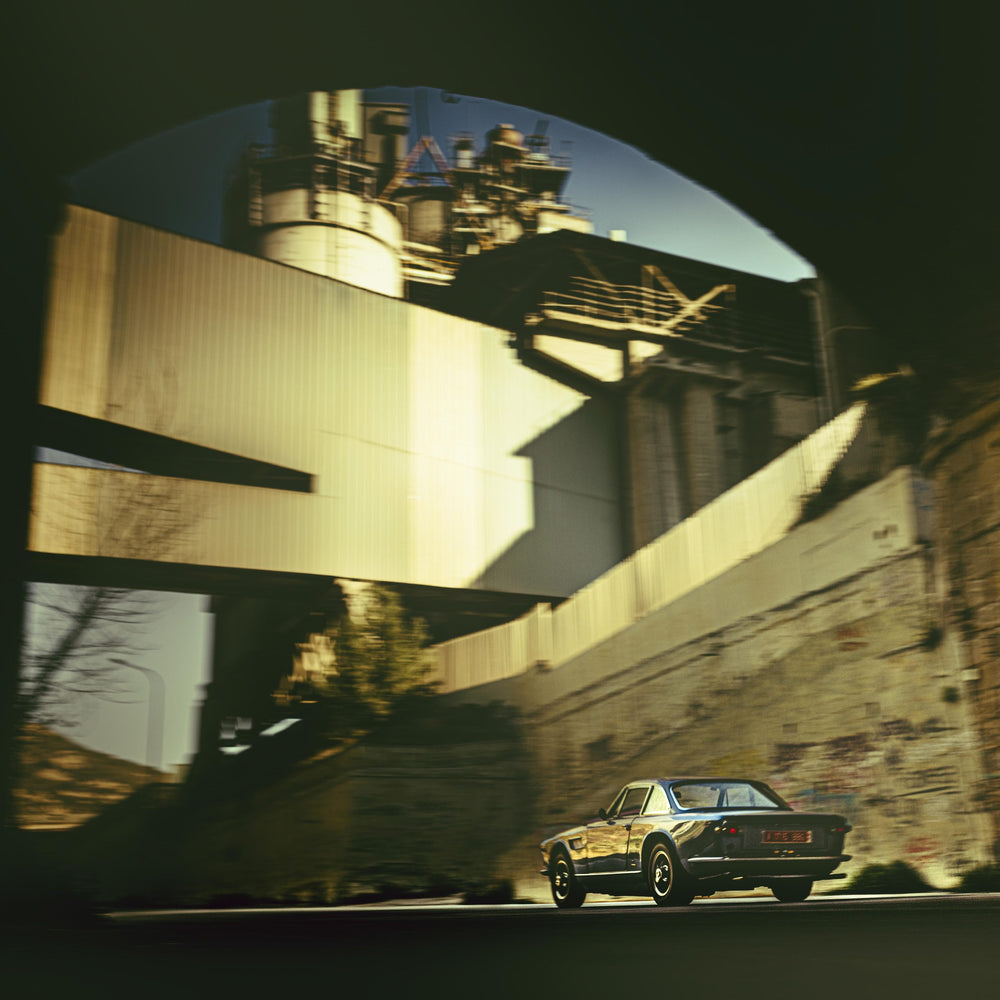Where the waves of the sea find the shore, in a secluded gulf on a ragged coast, a strange place reveals itself. It’s not a resort, not a fishing village, nor a garden or a palace, and it’s not what you might expect from a scenic location on the shores of the Mediterranean. Walk past the tree line and you find the telltale signs of massive machinery, clad in weathered concrete and covered in the patina of hardened dust and salted wind. Is it pretty? Not in the typical sense. Although if you look closer, there is a sense of pride. After all, there was an age when industrial buildings were seen as temples of the utopian future to come, rather than husks of what once was.



It’s in places like this, existing in a twilight zone between the real and the mysterious, that driving the right car unlocks the emotional side of the area that might otherwise seem devoid of any. Without the car, the walls feel cold despite the sunshine streaked across them, the waves on the shore seem silent and lifeless, with no stories to tell; the atmosphere is more like a void than a place where life happens. And then, with just one more ingredient, it all makes sense and the stories—real and imagined—of this place bloom one after the other in the mind.




The catalyst in this story is a piece of exquisite automotive design. Burbling right next to me in this earth-toned concrete maze is an appropriately golden Maserati Sebring, a car so effervescent and elegant you expect the doors to close with a champagne glass “clink.” A vessel for a luxurious lifestyle of bygone times, transporting you to smoke-filled ballrooms packed to the brim with people who rarely refuse themselves any of the pleasures life has on offer. It’s always been funny to me how unabashed hedonism is acceptable as long as the aesthetics are elevated, and this car is a perfect example. Entering the cavernous tunnel under the railway bridge, on the way to the factory’s entrance, one can’t help but feel like a bygone industrial magnate.






While Mr. Big in his Maserati probably wasn’t clocking in to a day of breaking rocks under the sun, that’s the kind of work that went on here. The kind of unglamorous work that nowadays not many people would consider as a career choice, but that, a few decades ago, was a potential ticket to a stable and not unhappy life. It was crushing work, stretching body and will to the extremes, but it was the kind that broke mountains, not people. Literally. And the muscular bodywork of our Italian car reflects some of that attitude. Sure, it has some chrome embellishments and the usual flair of an expensive car, but it also feels tense and athletic, more masculine and purposeful than a typical dalliance into automotive luxury.
While it was never expected of the directors of a cement company to share the physical burden with their blue collar employees, they should at least be in tune with them. This is no place for a voluptuous Giulietta Spider or a frivolous racing inspired barchetta. That said, it would be ridiculous to equate the Maserati Sebring with the modern day foreman’s shiny F-150 on the job site.







In 1957, Maserati won the 12 Hours of Sebring. A few years later, in 1962, the first generation Maserati Sebring road car was introduced. A luxurious powerful car, designed as a successor to the legendary 3500 GT. But why would you name a grand tourer after a race victory? It’s not a bonafide sports car, it’s not at all meant to replicate the sensations of a hard fought win on the track. This car is potent but overall comfortable way to get around, and never meant for drag racing at the stoplights, never mind engaging in a grueling endurance contest on the track. It’s much more akin to an old fashioned in a highball glass than to a freshly opened RedBull chugged from the can. It’s fair to assume that marketing alone is to blame for such an inappropriate naming exercise. Sales reps could benefit from an easy icebreaker to introduce the car to its punters. And that would be it, no further meaning necessary. After all, as with all cars, the shape quickly prevails as the mental image of the word, once you become familiar with it.



A Sebring will not bring up an image of a racetrack to its owner no more than a Porsche Cayman conjures images of the Caribbean. And yet, having spent some lovely hours in the company of a Maserati Sebring 2, I can’t help thinking that I might have discovered something more. I first saw this car at Auto Storica, in Barcelona. Their headquarters is always populated with fine classic cars, from lavish Ferraris to race-bred Jaguars, so for a car to stand out it must have something unique to it.





The Sebring 2 is not an overtly flashy car; it’s not made to shock and awe. The people who would choose such a car would not feel that they have something to prove. On the contrary, this car was for those with a lot to spend but with little to prove in doing so. It’s for those who find no point in bragging about a life that includes a fair share of brag-worthy fodder.
This photoshoot was done in the morning, staving off the ruthless heat of the mid afternoon sun, and we are nested in shadows that coat this place in contrast. The spirit of some imagined “last night” is still here, not yet washed out by the following day. That’s the essence of this car. It skirts the line between hedonistic and no-nonsense seemingly without compromise on either end, fitting in equally well in posh valet lines as it does here among the sunbaked remains of heavy industry and hard labor.
































































